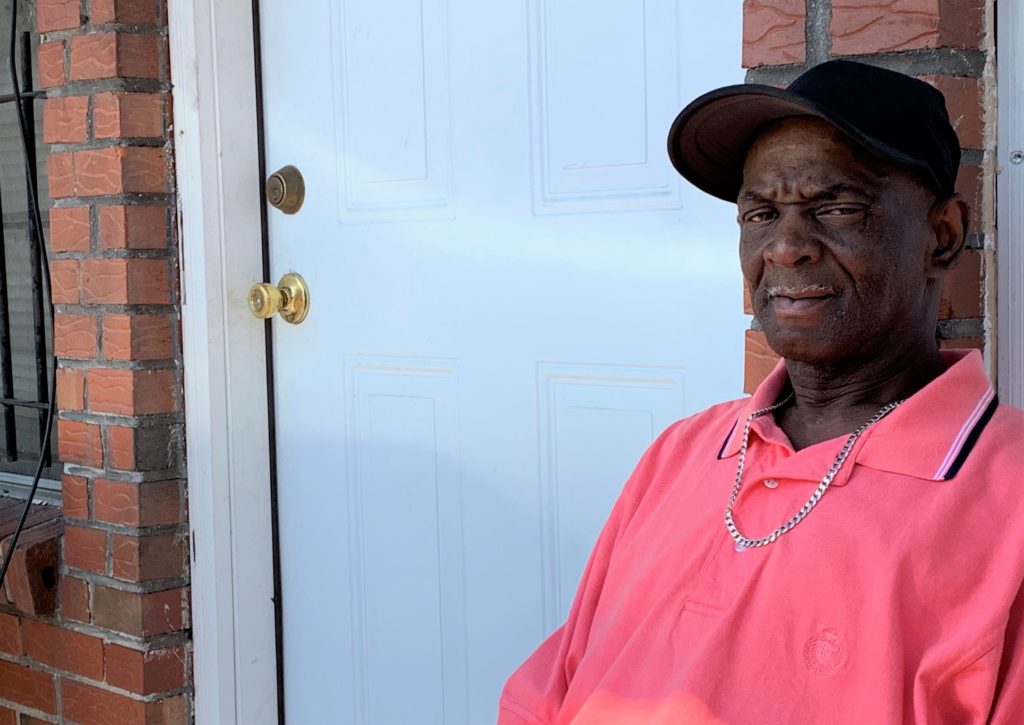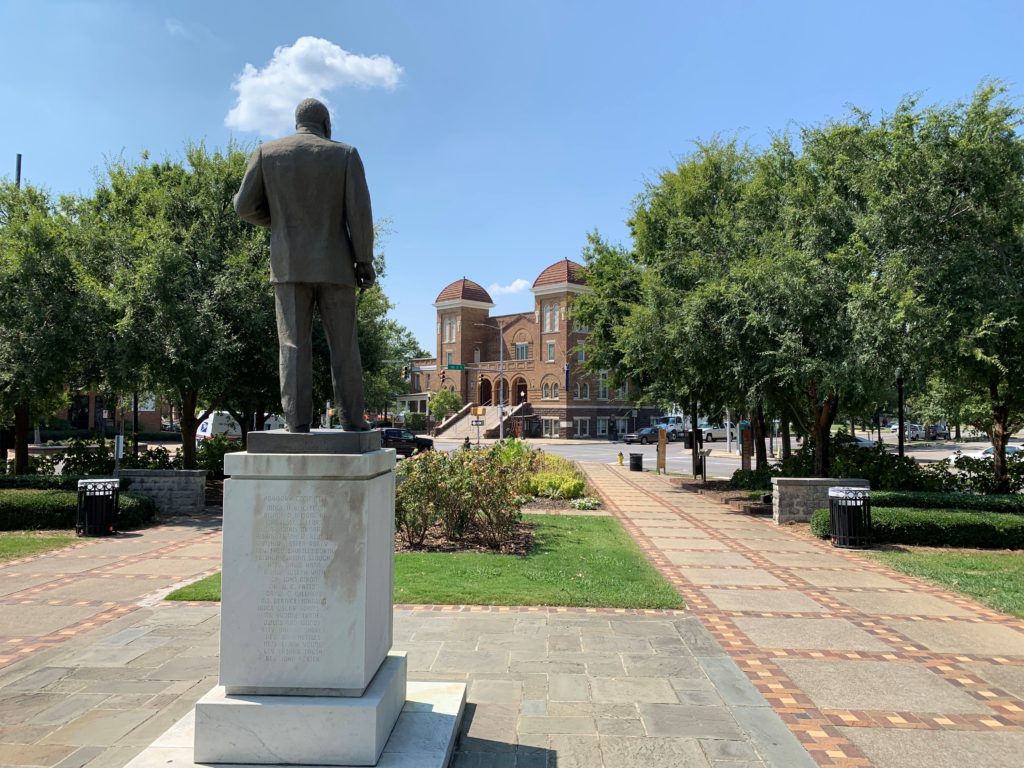This article is published in partnership with AL.com.
Introduction
The Center for Public Integrity is a nonprofit newsroom that investigates betrayals of public trust. Sign up to receive our stories.
BIRMINGHAM, Alabama — The first thing a visitor notices when walking into Tommie Jackson’s Birmingham apartment is the cave-like darkness. Blinds covering the front window block even the smallest of rays from the sun, which is baking the front of the building in nearly 100-degree heat. The room is just slightly cooler.
Jackson apologizes. “I’m trying to keep my air conditioning bill low,” he explains.
Jackson, 58, says he would like to move from the two-story, red-brick apartment complex, if only to provide his 5-year-old son a better place to play than the parking lot just outside his front door. Working six days a week for $9 an hour as a janitor at the University of Alabama Birmingham Hospital, however, he can’t afford anything better. Here in Birmingham, Jackson pays $350 a month, with additional help from a rental subsidy, for his small, two-bedroom unit, which lies a few hundred feet from two interstate highways. The incessant drone of traffic wakes him up at night.
Hope was supposed to come in the form of a tax incentive program created by the Tax Cuts and Jobs Act, signed by President Donald Trump in 2017. Less than two miles from Jackson’s apartment on 12th Street North — past Kelly Ingram Park, where nearly 60 years ago Birmingham police used dogs and firehoses to attack civil rights demonstrators — a $24 million renovation is under way on a vacant, 12-story building most call by its former name, the American Life Building.
The project, when completed this year, will offer one-room apartments with rents that start at $690 a month and average $926, according to a list provided to the Center for Public Integrity by the property manager. Two-bedroom units will cost $1,344 a month.

The renovations were made possible in part by the tax law, which allows wealthy investors to reduce their taxes on profits from the sale of assets if they sink the money into economically distressed areas called “opportunity zones.” The investments are supposed to provide low-income residents with higher-paying jobs, retail shops and decent, affordable housing.
“With opportunity zones, we are drawing investment into neglected and underserved communities of America, so that all Americans, regardless of ZIP Code, have access to the American Dream,” Trump said at a 2018 White House event.
The renewal of the American Life Building has been lauded by the Trump administration and other boosters as exactly the kind of project the program’s generous tax benefits should fund. But for Jackson and thousands of others who live in the half-dozen opportunity zones that blanket Birmingham’s downtown, the price is too high.
“There’s no way I can afford that rent,” said Jackson, who makes about $24,000 a year.
That’s because the American Life Building, like many of the housing projects funded nationwide in these opportunity zones, isn’t being built for the low-income people who live in the zones. The project’s developer, Ed Ticheli, has said he would target young professionals, graduate students attending the nearby university and people commuting into the city.
That isn’t because Ticheli and city officials set out to ignore low-income residents of the neighborhood. It’s the way longstanding federal guidelines for affordable housing work. The apartments in the American Life Building meet the criteria because some units have rents that are manageable for people earning 50 percent of area median income (AMI) in metropolitan Birmingham, according to PNC Bank, which has invested in the project and uses a number of sources to calculate affordability, including AMI.
According to data from the U.S. Department of Housing and Urban Development, this means couples in the area earning $29,800 a year or a family of four earning $37,200 a year should be able to afford some of the apartments. Those numbers, however, are thousands of dollars above the $23,100 median household income earned by those who live in the opportunity zones in and around downtown Birmingham.
“This building is doing the best this program can do, and it’s still not enough to help most of the residents in this neighborhood,” said Brett Theodos, who studies opportunity zones for the Urban Institute, a nonpartisan think tank in Washington, D.C.
‘Biggest program since Great Depression’
Opportunity-zone tax incentives were first introduced in 2016 in a bill sponsored by Sens. Tim Scott, R-S.C., and Cory Booker, D-N.J., the latter a presidential candidate until last month. Scott, who grew up poor in North Charleston, South Carolina, said the tax breaks would “dramatically expand the resources to restore economic opportunity, job growth, and prosperity for those who need it most.” The legislation was drafted by the Economic Innovation Group, a bipartisan think tank in Washington, D.C., whose founders include Facebook Inc. investor Sean Parker; Steve Glickman, a former economic adviser to President Barack Obama; and John Lettieri, an former aide to Republican Sen. Chuck Hagel from Nebraska.
Scott, who did not respond to a request for comment from Public Integrity, has vigorously defended the program from criticism that it benefits the wealthy, charges he recently called “laughable.”
In 2017, the bill’s language was folded into the Tax Cuts and Jobs Act. Investment managers and developers were giddy over the generous tax benefits, predicting investors would pour billions into the zones. Treasury Secretary Steve Mnuchin said the figure could be as high as $100 billion; others saw a ceiling of $2 trillion. Congress and the White House issued more modest estimates of between $8 billion and $10 billion.
The precise number may never be known. The tax law doesn’t require the tracking of what happens in opportunity zones — the amount of money invested, who is investing, or how the money is being invested. The government and fund managers also have no obligation to measure the effects of the investments, such as the number of jobs created or affordable housing units built.
The lack of hard data hasn’t stopped the investment community from boasting about how the tax incentives will benefit low-income people. “This is the biggest program since the Great Depression,” Manny Friedman, CEO of hedge fund EJF Capital in Arlington, Virginia, said last year at a seminar in Washington.
An opportunity-zone council created by the White House issued a report in December claiming the “administration’s priority is to help the forgotten men and women of America — particularly those living in economically distressed communities.” One of the goals is to develop “quality housing stock.” The council highlighted 223 recommendations it said will encourage public and private investment in the zones; one “noteworthy” accomplishment, it said, was the creation of the website opportunityzones.hud.gov.
Nearly two-thirds of opportunity-zone funds — pools of money collected from commercial banks, investment firms and wealthy individuals and overseen by private managers — claim interest in affordable housing and community development, according to a directory published by the National Coalition of State Housing Agencies.
So far, however, investments that benefit low-income families are rare. The Economic Innovation Group has identified at least five dozen opportunity-zone projects nationwide that have affordable housing components. Of these projects, less than 20 percent of the housing units offer rents for people earning less than 80 percent of AMI, according to a Public Integrity analysis. About 1 percent target families with extremely low incomes — those making 30 percent of AMI or less. Most of the units are set to rent at market rates.
OUT OF REACH: Rents at the American Life Building are expected to average $926 a month for one-bedroom units. That’s too much for most low-income residents of the neighborhood.
| Number of units | Style | Square footage | Average asking rent at American Life Building, $ |
| 2 | 1 bedroom loft | 450 | 990 |
| 1 | 1 bedroom loft | 475 | 1,045 |
| 2 | 1 bedroom loft | 480 | 1,056 |
| 1 | 1 bedroom loft | 500 | 1,100 |
| 1 | 1 bedroom loft | 750 | 1,650 |
| 1 | 1 bedroom loft | 770 | 1,694 |
| 11 | 1 bedroom flat | 300 | 690 |
| 22 | 1 bedroom flat | 340 | 782 |
| 11 | 1 bedroom flat | 350 | 805 |
| 11 | 1 bedroom flat | 400 | 860 |
| 11 | 1 bedroom flat | 434 | 935 |
| 11 | 1 bedroom flat | 435 | 935 |
| 22 | 1 bedroom flat | 450 | 968 |
| 11 | 1 bedroom flat | 470 | 1,011 |
| 11 | 1 bedroom flat | 580 | 1,247 |
| 11 | 2 bedroom flat | 625 | 1,344 |
Source: LMS Real Estate Investment Management LLC
The tax law allowed governors to nominate for opportunity-zone status census tracts that had high poverty rates and below-average median family incomes. In 2018, the Treasury Department designated more than 8,700 zones nationwide. Collectively these areas include nearly 35 million people, almost a third of whom live in poverty.
After heavy lobbying by Birmingham officials, the Treasury Department designated 24 census tracts in the city as opportunity zones. Tommie Jackson’s neighborhood of Fountain Heights is in one of them. It sits in the northwest corner of the zone that covers downtown Birmingham, which can be seen from Jackson’s apartment complex, bounded by empty lots and vacant houses. About a dozen small duplexes and single-family homes line the street around the corner. Glass office buildings loom a couple of blocks away.
Birmingham has been aggressively marketing the zones, mostly to developers, saying it’s looking to reverse the impacts of the 2008 recession and job-killing globalization and automation. It set up a website to tout potential projects and created an investment and community task force that includes former NBA all-star and Alabama native Charles Barkley. HUD Secretary Ben Carson has held up the city as a glowing example of how the tax incentives can help residents of opportunity zones, saying the program had encouraged investment in “places that have pretty much been forgotten about.”
The city is working on at least 10 projects, some of which run into the hundreds of millions of dollars, said Josh Carpenter, who oversees opportunity-zone investments as head of Birmingham’s Department of Innovation and Economic Development. But it’s unclear if any will provide jobs or low-income housing. To date, office buildings and other commercial projects are the investments of choice, according to local media reports. Half a million dollars, for example, went toward the renovation of a historic concert venue called the Woodlawn Theater, east of downtown.
Restaurant and retail workers
The planned renovation of the nearly 100-year-old American Life Building to create 140 apartments attracted national attention.
In April 2019, Birmingham’s Democratic mayor, Randall Woodfin, was joined by Democratic mayors Eric Garcetti of Los Angeles and Steve Benjamin of Columbia, S.C., when he announced the project. Opportunity zone tax incentives allow “us the opportunity to attract private development and private investment into these areas where people probably would have ignored,” Woodfin said, standing in front of the dilapidated building.
Woodfin’s office declined to answer questions about the American Life Building from Public Integrity, referring reporters to Carpenter. Ticheli, the building’s developer, said last year in a press release that the project will make it possible for restaurant, retail and health-care workers to live downtown and eliminate hour-plus commutes from the suburbs. But most of these workers won’t be able to afford the rents, which will average $926 a month and run as high as $1,694 a month.
➤ $22,570: Average annual wage of a Birmingham worker in the food-preparation industry, which includes 45,300 employees who work as cooks, waiters, dishwashers, bartenders and hosts, according to the Bureau of Labor Statistics. Maximum affordable rent: $564 a month.
➤ $27,960: Average annual wage of a Birmingham retail salesperson. Maximum affordable rent: $699 a month.
➤ $37,040: Annual average wage needed to afford the $926 average monthly rent for a one-bedroom unit in the American Life Building.
Ticheli declined to be interviewed through a publicist who said the developer was concerned about the negative media coverage of opportunity zones. In an emailed statement to Public Integrity, the publicist, Francis Hare quoted Ticheli as saying it has been his dream to “provide affordable housing in Downtown Birmingham for working people and families. Before the American Life building was designated an Opportunity Zone project, this dream simply was not economically feasible.”
Ticheli is carving up the building into small apartments, which average 422 square feet, smaller than a standard room at Marriott’s Residence Inn in downtown Birmingham. The property manager, Patrick Harwell, a principal with LMS Real Estate Investment Management LLC, said the building’s design is on the “cutting edge” of urban living. Harwell said the units need to be smaller so the rents will fall within the price range that is in highest demand: $800 to $1,200 a month. Rents for downtown apartments with comparable amenities go as high as $1,600. Harwell said rents at the American Life Building could go up if demand is strong.
Harwell said rents would have to be $400 a month to make the units affordable to the average resident of the opportunity zones in downtown Birmingham — an impossibility given the costs of property acquisition and construction.
Ticheli agreed to set aside five of the building’s 140 apartments for young women from disadvantaged backgrounds who are part of a work development program managed by the nonprofit Dannon Project. Most are employed by the University of Alabama Birmingham, a few blocks away, Hare quoted Ticheli as saying in the email.
The American Life project received about $15 million in funding from PNC Bank — $11 million from the bank’s OPZONE Community Development Fund Inc. and a $4.2 million loan. Ticheli secured another $6.2 million in federal and state historic tax credits and $2 million from a state energy program. The city pitched in $420,000 to improve sidewalks and curbs.
PNC Bank said nearly a third of the units would be rented to people who earn 50 percent of AMI or less. But this excludes residents of surrounding neighborhoods who make far less.
“In a perfect world, all of our deals would absolutely benefit the folks that need it the most,” said Cathy Niederberger, PNC Bank’s head of community development banking. “But in a real world, what we’ve got to do is … make sure that what we’re financing does meet the [federal government’s] definition of community development. So, it’s not just affordable housing.”
‘They need to come here’
Tommie Jackson is among nearly 1,500 workers who live in the opportunity zone that includes the American Life Building. He’s presumably the kind of person Trump had in mind when he said such zones would draw investment into neglected neighborhoods and allow residents to realize the “American Dream.”
But for Jackson, the dream is out of reach. To pay the cheapest rent at the American Life Building, he said, he would have to give up his cell phone, cable TV and other “basic stuff.” Even though he works nearly 50 hours a week, Jackson said, he’s “living on the edge.”
At times, Jackson said he has trouble paying his utility bill — the reason he keeps his apartment dark. He was out of work for several weeks recently because of an eye ailment and said he couldn’t come up with the $50 co-pay for treatment. Last year, Jackson tried to earn more money by working seven days a week. “But my body is old,” he said, his polo shirt and shorts hanging loosely on his thin frame. “I can’t work like that no more.”
Jackson speaks in a thick Southern accent, a product of growing up in Alexander City, Alabama, a town of about 15,000 people southeast of Birmingham. He moved to the city five years ago in hopes of kicking a drug habit. Jackson said he has been in recovery ever since and his life is better. He is engaged to a woman he met at a grocery store.
When Jackson moved into his apartment on 12th Street North, he had nothing but an old TV and a wooden pallet that served as a stand. Now his apartment is fully furnished, thanks to the generosity of neighbors and friends. “I’ve accumulated all this by helping people move,” he said. “They give you a piece here and a piece there.”
On a blistering September day, Jackson sat on a couch beneath family photos taped atop a painting. Jackson said he is looking for a better place to live for his son and fiancée. The place he lives now is neat and small. But he worries about his son, whom he didn’t want to name, getting hit by a car when he plays in the parking lot. It’s also noisy. Jackson said he is awakened at night by traffic on the interstate and highway construction equipment a few hundred feet outside his bedroom window.
“It goes on all night — bam, bam, bam,” Jackson said. “I just had to get used to it.”
But Jackson’s search for a new apartment has proven difficult, and the opportunity zone won’t help him. No one he knows will be able to afford the American Life Building rents, he said.
“They talk about low-income housing? They don’t even know what low-income is,” Jackson said.

The opportunity zone in which Jackson lives has struggled economically. The poverty rate is 37 percent and the unemployment rate is 15 percent, more than four times the national rate, according to census data. The area suffers from crime, prostitution and addiction, said the Rev. Adam Burns, senior pastor at the Church of the Reconciler United Methodist Church, a mile south from Jackson’s apartment. The church is untraditional — it occupies a former meatpacking and processing plant — as is Burns, who has shoulder-length hair, a thick beard and is partial to wearing shorts.
Burns, who has two degrees in economics from the University of Alabama, doesn’t see how opportunity-zone investments in hotels, office buildings and businesses will help those who are struggling. “That doesn’t trickle down,” he said.
When Burns tries to help low-income people find housing, he said he rarely encounters monthly rents lower than $500 for a one-bedroom unit. The average in Birmingham is $760 — $70 more than the cheapest option the American Life Building will offer. Someone earning a bit more than minimum wage or on government assistance can’t afford that, Burns said. “How do you eat after paying rent and utilities?”
Demand for workforce housing
City officials have said the American Life Building isn’t for low-income workers. They say the project will provide workforce housing, a term used to describe residences affordable to families making between 60 and 120 percent of AMI, although most housing experts say the range is between 80 and 120 percent. In Birmingham, AMI is $74,400 a year, according to the latest HUD data. The American Life Building will allow nurses and teachers to live downtown, near where they work, said the city’s Carpenter.
“The demand for workforce housing is difficult to overstate,” he said.
The median household income in the opportunity zone that includes the American Life Building is only $20,862, according to census data. For the six surrounding zones, the median household income is $23,936. Most of the nearly 20,000 residents living in the opportunity zones in and around downtown Birmingham can’t afford the rents at the American Life Building.
‘If the opportunity-zone program was designed to actually benefit low-income people living in these neighborhoods, it would have been designed very differently.’
Chris Schildt, Senior associate at PolicyLink
“If the opportunity-zone program was designed to actually benefit low-income people living in these neighborhoods, it would have been designed very differently,” said Chris Schildt, who advises cities on anti-displacement practices at PolicyLink, an Oakland, California-based nonprofit that develops policies to advance racial and economic equity.
Schildt said affordable housing should be built so that workers earning minimum wage, or slightly more, can afford the rents. (In Birmingham, the minimum wage is $7.25 an hour.) She said the 2017 tax law should have been written to allow people and organizations in opportunity zones to pool their money and invest in affordable housing. But the law gives tax breaks only to investors who realize capital gains and sink that money into the zones. Poor people don’t have these sorts of assets, Schildt said.
Schildt added that allowing rents to be set by the market, as the American Life Building’s developers plan to do, carries the risk of rents being pushed up by demand from higher-income workers, further outpricing low-income residents.
Birmingham, like most cities, has an adequate supply of workforce housing, according to the National Low Income Housing Coalition, a nonpartisan affordable housing advocacy and research group in Washington. For every 100 families earning 80 percent of the AMI in the Birmingham metro area, there are 103 affordable units available, the group says. (The ratio nationally is 102 units for every 100 families.)
But for families earning far less than the AMI, such as Tommie Jackson, Birmingham has a severe housing shortage. Only four of every 10 families can find adequate housing at affordable prices, the coalition reports.
Echoing other economic development and housing officials, the city’s Carpenter said opportunity zones by themselves can’t meet low-income families’ housing needs. Other tax incentives and direct grants are required to make projects viable, he said.
Ivan Holloway, who runs Urban Impact Birmingham, a nonprofit group working to improve the economy in the Civil Rights District downtown, commended Ticheli for reserving five units in the American Life Building for very low-income residents. But Ticheli missed a “perfect opportunity” to have a much bigger impact on the community, Holloway said. Instead of five, why not 125?
Holloway said he regularly works with city officials on economic development issues, especially in the downtown area, but no one contacted him to discuss the city’s plan for opportunity zones. That was unusual, Holloway said. The renovation of the American Life Building “was way down the line before I heard anything about it,” he said.
Hotels and office buildings
The tax law doesn’t specify the types of opportunity zone projects investors can back. Rather, Internal Revenue Service rules lay out what can’t be funded, banning investments in golf courses, massage parlors, tanning salons, liquor stores and gambling establishments such as racetracks.
The law also offers big tax breaks, including no taxes on capital gains from the sale of properties in opportunity zones — providing they are held for more than 10 years. Critics say that encourages investments in projects that have the biggest returns. Affordable housing, developers say, offer significantly lower returns than, say, hotels.
Or office buildings. Somera Road Inc., a development company based in New York City, has invested opportunity-zone funds in 10 real estate projects, said Ian Ross, founder of the company. All the investments are office developments, including two buildings in Nashville, Tennessee, and another one in Allentown, Pennsylvania. Somera Road also has invested in office buildings in Cleveland and Louisville, Kentucky. Ross said Somera Road will consider investing in affordable housing, but “the deal has to work” financially.
When Ross first heard about the tax incentives, he said he overlaid a map of opportunity zones with a map of his firm’s planned and existing projects. “We were like, ‘Holy cow, there’s a huge overlap. These are markets we’ve invested in already,’” he recalled saying. “‘This is going to be incredible.’”
Relying solely on opportunity-zone funding to build affordable housing for low-income people is difficult — even for more socially minded investors. Boston-based Arctaris Impact Investors last year announced it would create a $500 million opportunity fund, capitalized by commercial banks, institutional investors and family trusts. Arctaris is working on two housing projects for people who earn less than 80 percent of AMI, one in Lewiston, Maine, and another in the Pacific Northwest.
But the financing of the projects is complicated, requiring numerous investment sources other than opportunity-zone money, said Jonathan Tower, Arctaris’s founder and managing partner.
Arctaris has an incentive to build affordable housing that other developers don’t, however. The Troy, Michigan-based Kresge Foundation, a philanthropy started nearly 100 years ago by the founder of the Kmart discount store-chain to revitalize cities, has agreed to cover up to $15 million in losses on transactions in connection with the fund’s commitment to invest at least $22.5 million in housing built for residents earning 80 percent of AMI or less, or in businesses creating jobs for residents.

The guarantee acts as insurance: If investors lose money in a project, Kresge will reimburse them. The Kresge money came with several conditions, including prioritizing development of affordable units, preventing displacement and creating living-wage jobs. (The Kresge Foundation has provided funding to Public Integrity. Read more about Public Integrity’s funders.)
In what’s almost unheard-of among opportunity-zone investors, Arctaris also agreed to track the impacts of its investments, such as the number of local residents employed in new jobs and affordable units created. The tax law doesn’t require such reporting.
Tower said it may be true that opportunity zones, alone, won’t lead to the construction of much housing for low-income people. The program, he said, is part of a broader solution that includes working with nonprofit partners and government agencies that can provide capital and other incentives such as free land or millions in cash.
Asked if such deals are rare, Tower said, “So far.” He added that $1 billion of opportunity-zone capital has been committed to low-income and workforce housing.
That leaves people like Tommie Jackson without much hope, other than to make more money.
To do that, Jackson said he needs more seniority at the hospital before he would be eligible for a raise to $12 an hour — $3 an hour more than he is making now. Even with a raise, he said, he still would be thousands of dollars short of being able to afford an apartment at the American Life Building.
“I’d have to go back to working seven days a week to afford that rent,” Jackson said. “But my body just won’t let me do that.”






Join the conversation
Show Comments